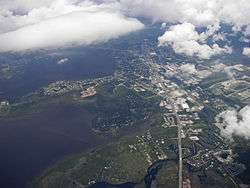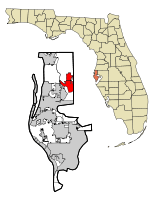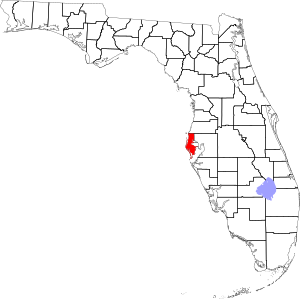Oldsmar, Florida
Oldsmar is a city in Pinellas County, Florida, United States. As of the 2010 census, the city had a population of 13,591.[5] The Oldsmar name dates to April 12, 1916 when automobile pioneer Ransom E. Olds purchased 37,541 acres (151.92 km2) of land by the northern part of Tampa Bay to establish "R. E. Olds-on-the-Bay". The name was later changed to Oldsmar, then to "Tampa Shores" in 1927, and finally back to Oldsmar in 1937. Ransom Olds named some of the original streets himself, such as Gim Gong Road for Lue Gim Gong.[6]
Oldsmar, Florida | |
|---|---|
 Aerial view of Oldsmar from the east | |
| Motto(s): Where Business Meets Prosperity | |
 Location in Pinellas County and the state of Florida | |
| Coordinates: 28°2′31″N 82°40′35″W | |
| Country | |
| State | |
| County | Pinellas |
| Area | |
| • Total | 10.10 sq mi (26.15 km2) |
| • Land | 8.94 sq mi (23.17 km2) |
| • Water | 1.15 sq mi (2.99 km2) |
| Elevation | 7 ft (2 m) |
| Population (2010) | |
| • Total | 13,591 |
| • Estimate (2019)[2] | 15,061 |
| • Density | 1,683.92/sq mi (650.13/km2) |
| Time zone | UTC−5 (Eastern (EST)) |
| • Summer (DST) | UTC−4 (EDT) |
| ZIP Code | 34677 |
| Area code(s) | 813 |
| FIPS code | 12-51350[3] |
| GNIS feature ID | 0288131[4] |
| Website | www |
Oldsmar includes several parks along Tampa Bay, historic bungalows, a downtown, and a commercial area along West Hillsborough Avenue. The historical society operates a museum in Oldsmar, and the city erected a new library in 2008. It also includes a thoroughbred racetrack called Tampa Bay Downs.
In hopes of returning to the days of "Old Florida", Oldsmar's downtown is currently undergoing redevelopment efforts. Oldsmar celebrates its history every year with Oldsmar Days and Nights, including parades, car shows (featuring the Oldsmobile), and carnival rides. Notable Oldsmar businesses include the nearby Tampa Bay Downs and the production office of Nielsen Media Research.
Geography
Oldsmar is located at 28°02′31″N 82°40′35″W.[7]
According to the United States Census Bureau, the city has a total area of 9.7 square miles (25.0 km2), of which 8.7 square miles (22.5 km2) is land and 0.97 square miles (2.5 km2) (9.83%) is water.[8]
History
There were only a handful of settlers in the area in 1916 when Ransom Eli Olds decided to purchase 37,541 acres (151.92 km2) on the northern tip of Tampa Bay from Richard Peters. At the age of 52, the inventor of the Oldsmobile and REO cars embarked on a grand undertaking, desiring to turn this untamed land into a bustling community. He paid $400,000 for the property: $200,000 in cash, $75,000 in bonds, and a $125,000 apartment house in Daytona Beach. The town was originally named R. E. Olds-on-the-Bay. The name was later changed to Oldsmar. In 1927 the name was changed again to Tampa Shores before being renamed to Oldsmar in 1937.
The early settlers sourced their drinking water from cisterns and individual wells. Cheesecloth was used to sieve out the mosquito larvae. The city built a tower in the 1920s, into which water was pumped every morning; sulfur water flowed from the taps. A faucet with St. Petersburg water was installed by the railroad tracks, becoming a popular source for drinking water. The nearest stores were in Tarpon Springs and Dunedin.
Strategically situated between Tampa and St. Petersburg, Oldsmar was ripe for development. The long bridges across the bay had not yet been built and the shortest way from Tampa to St. Petersburg was through Oldsmar. Olds designed a community for working people rather than for the wealthy. He used engineers and surveyors from Boston to design a well-platted community, modeled after Washington, D.C., with tree-lined boulevards leading from the bay to downtown. A power plant that served parts of Safety Harbor, Dunedin, and Clearwater was constructed. The streets were paved with oyster shells obtained nearby. Olds named many of the streets himself. Woodward, Jefferson, and Congress reminded him of Detroit. Olds named Gim Gong Road after a Chinese American horticulturist from DeLand, Florida. Gim Gong was working on developing frost-resistant citrus. The streets of Oldsmar were unusually wide and more than 20 miles (32 km) of sidewalk were installed. Over the years much of the sidewalks was buried under a layer of sand.
Advertisements glorifying the virtues of Oldsmar were placed in the Detroit papers. He used the slogan "Oldsmar for Health, Wealth and Happiness" and tried to entice northern companies by offering cheap labor. Olds spent $100,000 drilling the infamous oil well that yielded only water. It has been said that oil was poured into the well each morning to make it look like they had struck black gold. The well is now capped and sits on the grounds of the Tampa Bay Downs Racetrack. (There were three other such wells in Florida, one in Sarasota and two in the Panhandle, but none of them possessed the technology to drill through the Florida aquifer).
Special excursion trains ran from Detroit. The first regularly scheduled commercial passenger flight in the United States began operation in 1914 between Tampa and St. Petersburg. A yacht serving liquor from the islands would bring prospective homeowners from St. Petersburg. A 60-room hotel, the Wayside Inn, was constructed in 1921. The first floor housed a grocery store, drug store, and hardware store.
The first library in the city was started by the Woman's Club in 1919. In 1977 it was donated to the city and moved to State Street in the City Hall Annex. The first school in the city was located in a church at the intersection of Buckingham and Jefferson Avenues. Another early school had one room for first, second, third, and fourth grades; a second room for sixth, seventh, and eighth grades; and high school was in the hall. The post office was downtown in the middle of an animal park featuring alligators. During the 1921 hurricane, all the alligators escaped.
Original city plans included a golf course and a luxurious hotel on the bay, but neither ever materialized. A sawmill and foundry that made cast-iron engines for tractors and grove heaters were though established. The mill produced the sturdy Olds Chair (also called the Oldsmar Chair), made out of either yellow pine or cypress. It was similar to the Adirondack chair and was sold throughout the United States.
Olds provided financial backing for the Kardell Tractor and Truck Company to move into town. Renamed Oldsmar Tractor Company, Olds had hoped it would devise a machine to cut through palmetto roots, which had proven impervious to earth-moving technology of the day.
Oldsmar had farms of dairy, peppers, tomatoes, corn, gladioli, and grapes. In the early days, it was not uncommon for cattle and hogs to run loose through town. A huge banana plantation was established on the bay, but the winters were too harsh for it to flourish for long. The waters at the northern end of the bay were clean during the 1920s and '30s. Fishing, oystering, and crabbing were popular. Townspeople could take their catch to the Rex Cafe to be cooked; fish fries and dances were weekly events.
A casino was constructed by the bay, attracting busloads of people from Tampa and Pinellas County on weekends. The Oldsmar Casino later changed its name to the Two Bits Club.
Oldsmar's pier stretched out a thousand feet into Tampa Bay and during Prohibition, boats loaded with coconuts concealing bottles of rum would arrive there. The pier was sturdy and wide enough to accommodate two cars side by side.
The city sits on a plateau with an elevation never rising over 20 feet (6.1 m) above sea level. In 1921, the town was hit by a devastating hurricane. Large pine trees were uprooted and most of the town was flooded by water reaching levels 14 feet (4.3 m) above normal. Some of the city's oldest homes remain on Park Boulevard. Many homes still standing after the hurricane were moved by barge to St. Petersburg during the 1920s and 1930s.
Olds had over $4.5 million invested in the community by 1923. When he realized Oldsmar was not growing as anticipated, he began liquidating his assets by first selling unplatted parcels of land. The racetrack was nearly completed when he traded it for the Fort Harrison Hotel in Clearwater. The rest of the land was traded for the Belerive Hotel in Kansas. By the time Olds left town, he had suffered a loss of nearly $3 million. While Olds envisioned a city of 100,000, the population was around 200 when he left.
Harry A. Prettyman, a St. Louis promoter, and his associates continued to sell lots in town following Olds's departure. Prettyman staged promotional gimmicks like Gold Rushes where pieces of gold were buried on a vacant lot and everyone got to dig for it. In 1927 Prettyman was caught selling underwater lots. To avoid scandal, the town of Oldsmar was renamed Tampa Shores. It wasn't until 1935 that the last of the property owned by Olds was finally sold.
Demographics
| Historical population | |||
|---|---|---|---|
| Census | Pop. | %± | |
| 1930 | 280 | — | |
| 1940 | 315 | 12.5% | |
| 1950 | 345 | 9.5% | |
| 1960 | 878 | 154.5% | |
| 1970 | 1,538 | 75.2% | |
| 1980 | 2,608 | 69.6% | |
| 1990 | 8,361 | 220.6% | |
| 2000 | 11,910 | 42.4% | |
| 2010 | 13,591 | 14.1% | |
| Est. 2019 | 15,061 | [2] | 10.8% |
| U.S. Decennial Census[9] | |||
As of the census[3] of 2000, there were 11,910 people, 4,536 households, and 3,329 families residing in the city. The population density was 1,335.9 inhabitants per square mile (515.5/km2). There were 4,839 housing units at an average density of 542.8 per square mile (209.5/km2). The racial makeup of the city was 90.44% White, 2.96% African American, 0.29% Native American, 2.80% Asian, 0.16% Pacific Islander, 1.29% from other races, and 2.07% from two or more races. Hispanic or Latino of any race were 6.67% of the population.
There were 4,536 households, out of which 37.5% had children under the age of 18 living with them, 56.9% were married couples living together, 12.1% had a female householder with no husband present, and 26.6% were non-families. 19.6% of all households were made up of individuals, and 5.6% had someone living alone who was 65 years of age or older. The average household size was 2.60 and the average family size was 3.00.
In the city, the population was spread out, with 26.6% under the age of 18, 6.6% from 18 to 24, 35.2% from 25 to 44, 20.4% from 45 to 64, and 11.2% who were 65 years of age or older. The median age was 36 years. For every 100 females, there were 93.4 males. For every 100 females age 18 and over, there were 90.5 males.
The median income for a household in the city was $50,354, and the median income for a family was $53,142. Males had a median income of $37,083 versus $30,329 for females. The per capita income for the city was $21,671. About 2.8% of families and 4.8% of the population were below the poverty line, including 4.6% of those under age 18 and 4.9% of those age 65 or over.
Economy
Oldsmar hosts an office of Nielsen Media Research. Most of the employees of Nielsen Media Research work in Oldsmar and the company's media measurement work originates from the office. The Associated Press said that the Oldsmar building, with a cost figure of $80 million, was its "nerve center." In 2003 the company moved into its Oldsmar complex and consolidated its employees there, with workers from Dunedin and other areas in Pinellas County moving into the Oldsmar building.[10]
Education
Oldsmar is part of the Pinellas County Schools district and is served by Countryside High School, along with sections served by East Lake High School.
Notable people
- Francis Biondi, Finalist on FOX's MasterChef US Season 5 and professional golfer.
- Cito Gaston, MLB all-star outfielder, two-time World Series Champion and first African-American manager to win a World Series.
- Gene Michael, professional baseball player, and former manager of the New York Yankees
Gallery
 R.E. Olds Park Dock Panoramic photograph into Upper Tampa Bay
R.E. Olds Park Dock Panoramic photograph into Upper Tampa Bay
References
- "2019 U.S. Gazetteer Files". United States Census Bureau. Retrieved July 2, 2020.
- "Population and Housing Unit Estimates". United States Census Bureau. May 24, 2020. Retrieved May 27, 2020.
- "U.S. Census website". United States Census Bureau. Retrieved 2008-01-31.
- "US Board on Geographic Names". United States Geological Survey. 2007-10-25. Retrieved 2008-01-31.
- "Profile of General Population and Housing Characteristics: 2010 Demographic Profile Data (DP-1): Oldsmar city, Florida". United States Census Bureau. Retrieved May 7, 2012.
- Oldsmar Historical Society - Brief History of Oldsmar
- "US Gazetteer files: 2010, 2000, and 1990". United States Census Bureau. 2011-02-12. Retrieved 2011-04-23.
- "Geographic Identifiers: 2010 Demographic Profile Data (G001): Oldsmar city, Florida". United States Census Bureau. Retrieved May 7, 2012.
- "Census of Population and Housing". Census.gov. Retrieved June 4, 2015.
- "Univision sues over Nielsen's meters." Associated Press at the St. Petersburg Times. June 11, 2004. Retrieved on August 28, 2011.
(Excerpted from Reflections of Oldsmar, 1996)
- Ransom Eli Olds and the American Dream contributed by Ann Liebermann
- Modern Oldsmar: Rediscovered at Last contributed by Paula Geist
